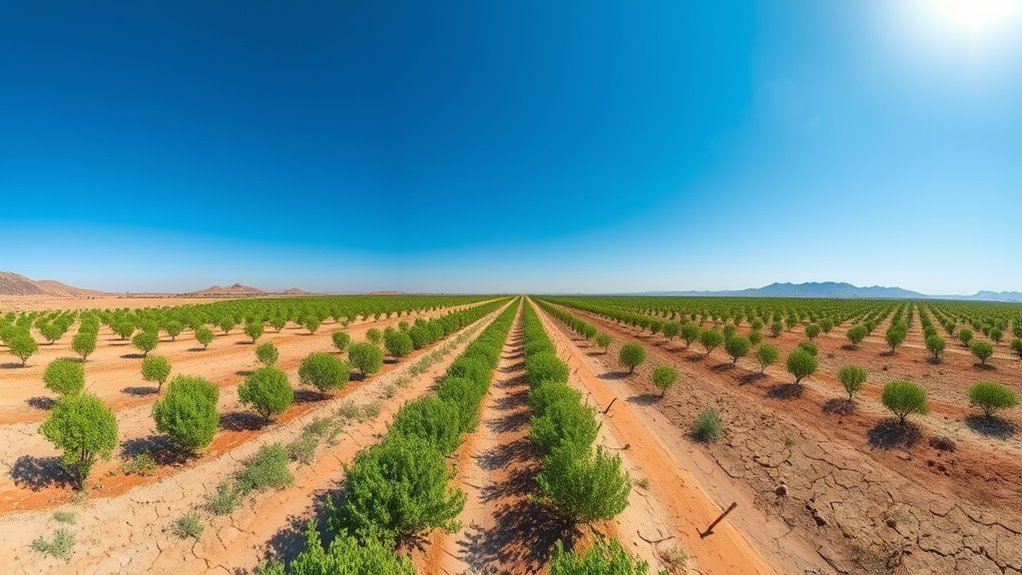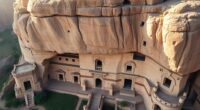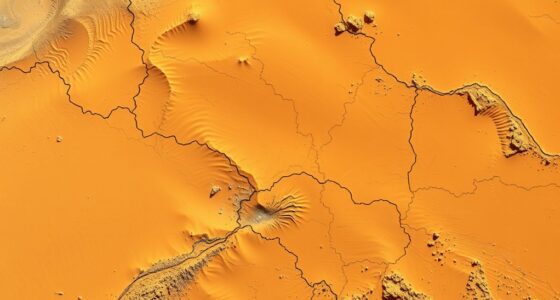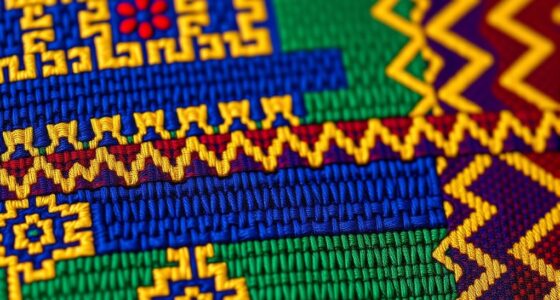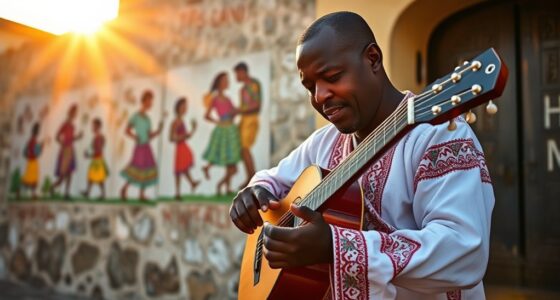The Great Green Wall measures Africa’s ambitious effort to fight desertification by planting a vast, living barrier of native trees across vulnerable Sahel and Sahara regions. This project promotes sustainable forestry, restores degraded land, and creates microclimates that support crops and livelihoods. It involves local communities, ensuring long-term environmental and social benefits. To learn more about how this innovative initiative is transforming Africa’s landscape and resilience, keep exploring its progress and impacts.
Key Takeaways
- Progress is measured by the length of the green wall, which has reached over 8,000 km across multiple countries.
- Satellite imagery and remote sensing track land restoration, vegetation cover, and desertification reduction over time.
- Community participation metrics assess local involvement, livelihoods improved, and sustainable management practices.
- Environmental indicators include increased soil fertility, water retention, and microclimate improvements in targeted areas.
- Monitoring reports evaluate project impact on biodiversity, ecosystem resilience, and long-term sustainability outcomes.
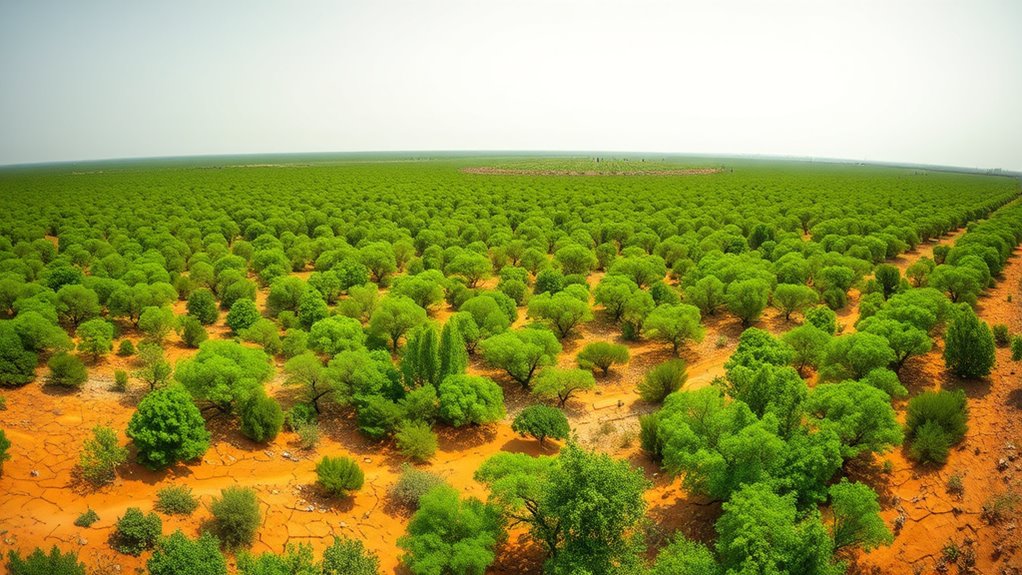
Have you ever wondered how Africa is fighting desertification and land degradation? The Great Green Wall is a bold, continent-spanning initiative designed to combat these pressing issues by creating a living barrier of trees across the Sahara and Sahel regions. This project isn’t just about planting trees; it’s about restoring ecosystems, empowering communities, and guaranteeing a sustainable future. One of the key strategies behind the Wall’s success is sustainable forestry. By promoting practices that protect existing forests and ensure new plantings thrive over the long term, the project minimizes environmental harm and boosts resilience against further land degradation. Sustainable forestry techniques include selecting native species, practicing agroforestry, and managing forests in ways that preserve biodiversity and improve soil health. These efforts help combat desertification mitigation by stabilizing soil, reducing erosion, and increasing water retention, which are essential for restoring degraded lands.
As you look at the vast stretch of the Green Wall, you realize it’s not just a physical barrier but a symbol of hope. The trees act as windbreaks, slowing the relentless movement of sand and dust that threaten local communities and agriculture. They also create microclimates that encourage the growth of grasses and crops, fostering a more productive and sustainable environment. This approach directly tackles desertification mitigation by restoring land’s productivity and preventing its further spread into arid areas. The project involves local communities in planting and maintenance efforts, guaranteeing that the green barrier becomes a shared responsibility and a source of livelihood. This community involvement is vital because it guarantees that the project is sustainable in the long run, both environmentally and socially.
Moreover, the Green Wall emphasizes the importance of sustainable forestry as a core component of land restoration. By integrating trees into agricultural landscapes through agroforestry, farmers can improve soil fertility and water availability while maintaining crop yields. This synergy reduces pressure on natural forests, helping to prevent deforestation and land degradation elsewhere. The project also encourages the use of native species adapted to local conditions, which enhances the resilience of the landscape against climate extremes. Together, these strategies create a cycle of land regeneration that supports local economies and promotes environmental stability. Ultimately, the Green Wall exemplifies how targeted, sustainable forestry combined with concerted desertification mitigation efforts can transform some of the world’s most vulnerable lands into thriving ecosystems, offering hope to millions across Africa.
Frequently Asked Questions
How Is the Project’s Success Measured Over Time?
You measure the project’s success over time through policy evaluation and community engagement. By appraising policies’ effectiveness, you determine if they support sustainable land management. Engaging local communities helps track improvements in livelihoods and ecosystem health. Regular monitoring, data collection, and feedback ensure you’re gauging progress accurately, making adjustments as needed. This approach keeps you focused on long-term impact, ensuring the project effectively combats desertification while empowering local populations.
What Challenges Do Local Communities Face During Implementation?
Imagine standing at the edge of a once-fertile land now battling sandstorms. You face challenges like limited resources, drought, and difficulty in community engagement. People struggle to manage resources effectively, balancing conservation with daily needs. Resistance to change and lack of awareness can hinder progress. You must foster strong community ties, educate locals, and guarantee resource management is sustainable, so everyone can work together to restore the land and protect their future.
How Is Funding for the Project Sustained Long-Term?
You focus on ensuring financial sustainability by diversifying funding sources, like government grants, international aid, and private investments. Community engagement plays a crucial role, encouraging local participation and ownership, which helps secure ongoing support. By fostering strong partnerships and demonstrating tangible benefits, you can maintain long-term funding, keeping the project active and effective against desertification. This approach creates a resilient system that adapts and persists over time.
What Specific Species of Trees Are Being Planted?
You’re curious about the tree species thriving in biodiversity hotspots, aren’t you? Specific species like acacia, baobab, and eucalyptus are often planted along the green wall. These trees are chosen for their resilience, ability to combat desertification, and support for local biodiversity. By planting diverse, drought-tolerant species, you help create a thriving tapestry of life that sustains ecosystems, protects soil, and promotes long-term environmental resilience.
How Does the Project Adapt to Climate Change Impacts?
You can see how the project adapts to climate change impacts through its focus on climate resilience and adaptive strategies. By selecting drought-resistant tree species and enhancing soil health, you help improve ecosystems’ ability to withstand climate shocks. The project also involves community engagement and flexible planning, allowing it to respond to changing conditions and guarantee long-term sustainability. These adaptive strategies are essential for maintaining the wall’s effectiveness against desertification.
Conclusion
As you stand before the Great Green Wall, imagine it as Africa’s breathing ribbon of hope, weaving life through desert’s grasp. This ambitious project is more than just trees; it’s a powerful heartbeat fighting against the silence of sands. With each sapling planted, you can see the promise of a greener future taking root, transforming barren lands into vibrant corridors of resilience. The wall isn’t just growing—it’s awakening the soul of a continent.

